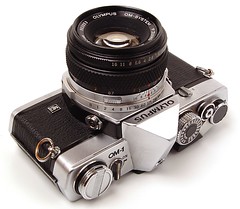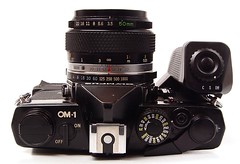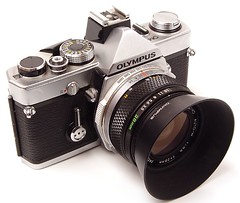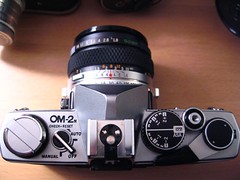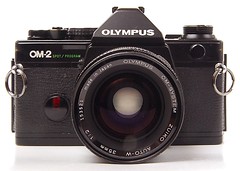The Olympus OM system was released by Olympus in 1972. The Olympus OM bodies are divided in a high range and a middle range. The one-digit models, discussed in this article, are the high range. The middle range are the two-digit models OM-10/20/30/40. All these bodies can take Olympus OM lenses.
The OM-1 (M-1) and OM-2
The very first model was presented at the Photokina of Cologne in 1972[1] and was called the Olympus M-1. Thirteen years earlier, the release of the Nikon F had done much to make the 35mm SLR the standard choice for professionals and higher-spending amateurs who would previously have used Leica and other rangefinders, but it had driven the market towards heavy and bulky cameras. The Olympus M-1 changed this and with it began a reduction of size, weight and noise of the 35mm SLRs. It was designed by a team led by Yoshihisa Maitani, who had already created the Olympus Pen and Pen F cameras, noted for their compactness.
Very soon a complaint from Leica forced Olympus to rename the M-1 to OM-1, and apart from the name the two models are identical. Today bodies and lenses with the M name are reputedly uncommon and are sought after by collectors. A rumour, usually attributed to the Olympus company, says that only 5,000 bodies were made.[2] However research by Mark Dapoz led to an actual production estimate of 52,000.[3]
The OM-1 is an all-mechanical SLR. It has a very large viewfinder with interchangeable screens but a fixed prism. It also has a through-the-lens exposure meter controlling a needle visible in the viewfinder. It has a very compact body, whose form was retained in later models.
Originally, you had to modify the bottom plate to mount a motor winder on the OM-1. In 1974 was launched the OM-1MD (MD standing for Motor Drive), to which a motor drive can be attached with no modification. This new version wears a small plate marked MD on the front.
The OM-2 is the automatic version of the OM-1, presented officially in 1975 at the 31st Photo Salon in Paris. An OM-2 prototype was displayed in a showcase at the 1974 Photokina in Cologne, but none of its features was announced.[4] Externally it is nearly the same as the OM-1, but the shutter is electronic and the exposure is either automatic (aperture priority) or manual.
The exposure meter of the OM-2 is able to measure the light reflected by the film and compensate for any variation of light during long exposures; this is called off-the-film (OTF) metering. The exposure sensor also controls the flash exposure; this is called through-the-lens (TTL) flash automation. The OM-2 was the first camera to have these features. The TTL flash automation greatly simplifies flash exposure, and was quickly adopted by most other SLR cameras, while OTF metering was also adopted by some competitors, like the Pentax LX. The Olympus Quick Auto 310 flashgun was designed for the OM-2, which unfortunately is not compatible with the T series flash units introduced in 1979 together with the new OM-1n and OM-2n.
The OM-1N is the same as the OM-1 with the following modifications:
- a redesigned film advance lever
- a flash ready/sufficient LED in the viewfinder, as well as automatic X-sync regardless of the position of the speed ring and the FP/X switch, when it is used with a T-series flash unit mounted on Flash Shoe 4
The OM-2N, based on the OM-2, has the same modifications plus:
- a direct contact inside for Recordata backs
- an exposure compensation warning flag
- full-frame averaging at all shutter speeds
- 120 second exposure limit on auto (the OM-2 limit was 60 seconds)
All these models existed in chrome or black. According to this page of the OM Sales Information File, 25 examples of the black M-1 were made, and there was also a gold version of the OM-1n.
The OM-2SP / OM-2S
The OM-2SP was introduced in 1986, after the OM-3 and OM-4. In some markets, it was called OM-2S. Although its name suggests it is a continuation of the OM-2, it has more in common with the OM-4.
Compared to the OM-2n, the OM-2SP adds:
- programmed exposure automation (camera chooses both aperture and shutter speed), added to the aperture priority and manual modes
- a spot meter for use in manual mode
- a slightly modified body, with a fixed hot shoe
- the ISO range is extended from 1600 to 3200
- the viewfinder indicators are LCDs
- the self timer has mirror prefire
The OM-2SP / OM-2S only existed in black.
The OM-3 and OM-4
The OM-4 was a higher-end body with shutter speeds up to 1/2000, released in 1983. The body was slightly modified from the OM-2, with a new type of viewfinder including dioptric correction. With this camera Olympus introduced a new, versatile light-metering system. Besides the normal center-weighted metering the camera is equipped with a "Multi Spot" metering system that allows storage of up to eight measures on a 2% central spot before making an exposure. The camera's computer electronics calculate the mean of the memorized light values to determine the optimal shutter speed. If desired, the calculated value can be retained for several exposures by using a "Memo" switch. There are also two "Hi Light" and "Shadow" buttons that are used only with spot metering. The "Hi Light" button applies an exposure correction of +2 EV, and is used when you take a spot measure on a light-tone object and want a high-key picture. The "Shadow" button applies an opposite correction of -21/3 EV and is used when you take a spot measure on a dark-tone object and want a low-key picture. In addition to these two buttons, there is an orthodox exposure correction knob, around the rewind knob, that can be used both for average and spot measures. The LCD display, visible at the bottom of the viewfinder, shows the shutter speed and the average or spot measures, indicates if you are using any of the features described above, and gives some information about the flash.
The OM-4 was released at about the same time as the Nikon FA, which introduced matrix metering. The two systems were innovative but quite different: the OM-4 provides spot measures and does the necessary computations, but it lets the photographer determine how he wants the picture to be exposed, while the FA compares the light pattern of the picture with a databank of commonly-occurring photographic situations, allowing the photographer to work faster and even palliating his knowledge deficiencies and actually beginning to think for him. (Nikon's approach was the one that would prevail among future 35mm and digital SLRs.) Among the few cameras to have a multi-spot metering system after the OM-4 were the Hasselblad 205 FCC and the Rollei 6008, some of the most expensive medium format cameras.
The OM-3, released in 1984, is a mechanical version of the OM-4, with the same metering system but with a mechanical shutter, of course without electronic shutter speed control by the metering system. It has no TTL flash automation. It was produced until 1986, and did not sell in great quantities. People who wanted a mechanical body went on buying the OM-1n, which was sold at least until 1987, and those attracted by the multi-spot system would buy an OM-4. Its rarity means that its value today on the used market greatly exceeds that of an OM-4.
Both the OM-3 and the OM-4 only existed in black.
The OM-3Ti / OM-3T and OM-4Ti / OM-4T
The OM-4Ti was released in 1987 and replaced the OM-4. It was called OM-4T in some markets. It has the same body as the OM-4 except it is made of titanium, and it featured full-synchro integration with the stroboscopic F280 flash unit, allowing flash pictures beyond the X sync speed, up to a maximum of 1/2000 sec. This system was called Super FP sync, and was first featured on the OM-707. It was an answer to one of the OM's weaknesses: the low X sync speed of 1/60.
The OM-4Ti was released first with a champagne finish, and later in a black finish. Production ended in 2003.
The OM-3Ti, released in 1994, was an updated edition of the mechanical body OM-3 that had been stopped in 1986. It has the all-mechanical shutter of the OM-3, while its titanium housing and some other features are taken from the OM-4Ti. It has TTL flash automation, itself a rare feature on a mechanical body. It also has the same high-speed flash support as the OM-4Ti.
It was called OM-3T in some markets and was the last of the 'true' OM series (the OM-2000 followed in 1997, but it was not a true OM system camera). At the same time Olympus released a 35–80/2.8 zoom in OM mount.
The OM-X
During the design study of the OM-1, the Olympus design team led by Yoshihisa Maitani had worked on a completely modular camera: a 35mm equivalent of a Hasselblad, consisting of a mirror box with interchangable backs as well as finders and so forth. This extraordinary camera was built as a prototype, and was called the OM-X[5].
Notes
- ↑ Francesch, p. 167.
- ↑ This rumour was relayed by a previous version of this very page, and might have started as a mistake on one of the Olympus official websites.
- ↑ The Olympus M-1 Information Page by Mark Dapoz.
- ↑ Olympus OM-1 OM-2 OM-10 OM-1N OM-2N, Éditions V.M., p. 12.
- ↑ Maitani interview.
Bibliography
- Francesch, Dominique and Jean-Paul. Histoire de l'appareil photographique Olympus de 1936 à 1983. Paris: Dessain et Tolra, 1985. ISBN 2-249-27679-X.
- Olympus OM-1 OM-2 OM-10 OM-1N OM-2N, Ronan Loaëc, Michel de Ferrières, Jean-Maurice Corrèze, supervised by Gérard Bouhot, with the participation of Francis Delvert, 2nd edition revised by Serge Bergal, 1980, published by Éditions V.M., Paris, ISBN 2-86257-021-X
Links
General links
In English:
- OM series history page of the Olympus official website
- The Unofficial Olympus OM Sales Information File describes every part of the OM system
- The Olympus M-1 Information Page by Mark Dapoz
- OM-1N, OM-2N and OM-2SP Modern Classics at Photography in Malaysia
- OM SLR FAQ by R. Lee Hawkins
- Maitani Fan website by Chris Lee, with some details about the OM-X
- M-1, OM-1, OM-3, OM-3Ti and OM-4Ti at N. Maekawa's Manual Camera website (the main page is in Japanese)
- OM-1, OM-2S and OM-4 at Reijo Lauro's camera site
In French:
- OM-1, OM-1N, OM-2N and OM-4 at Lionel's 35mm-compact.com
In Spanish:
- OM-1 and OM-4Ti in the website of Hugo Rodriguez
In Japanese:
- OM-1 at La Chambre Claire
- Olympus page at Photograph and Camera by Tomoyuki Shimizu
In Chinese:
Literature and manuals
In English:
- US patent by Olympus: "Single lens reflex camera" describing the OM-1
- Downloadable manuals in the Olympus America official website
- A 1983 test of the OM-4 in the Italian magazine Reflex, available at the Nadir Magazine website
Repairs
- The Olympus Hardware Resource Page — online repair manuals, provided by Mark Dapoz, including tutorials for top cover removal and prism foam replacement
- OM-1 Repair — Basic shutter job in Robert Ian Axford's Camera-Works
- John Hermanson's Olympus OM Service
- OM-1 shutter at Robert Ian Axford's Camera Works
Photobloggers using the OM system
| Olympus Classic Cameras |
|---|
| Semi | Semi II | Six | Chrome Six | Flex | Standard | 35 | Ace | Pen | Pen F | FTL | OM-1/2/3/4 | OM-10/20/30/40 | OM-707 | OM-101 | XA |
